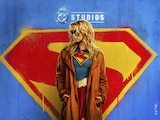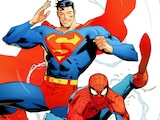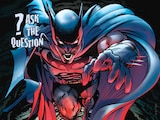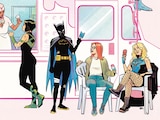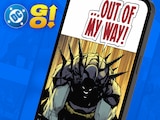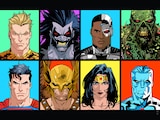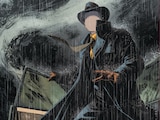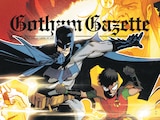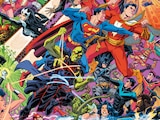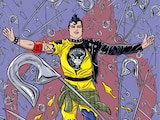John Stewart is my Green Lantern. My generation is now old enough to talk about how some of us were first introduced to the ring-slinger through the Justice League animated show over twenty years ago, where he was voiced by Phil LaMarr. Many of us had no idea that there was a white guy named Hal Jordan who came before John Stewart, and another white guy named Alan Scott who was the original GL. Regardless of how entrenched I’ve become in Green Lantern lore, there will always be an innate part of me that activates when I see John Stewart. He introduced me to the feeling of awe, and I’ll hold onto that forever.
Speaking of introductions, John Stewart first made his debut in 1971’s Green Lantern #87, by the indomitable duo of writer Denny O’Neil and artist Neal Adams. I don’t mean to sound hyperbolic with the adjectives, but there is a burning passion that emanates from the pages of this book. The issue was part of O’Neil and Adams’ game-changing run on Green Lantern that had a strong sense of social commentary.

The emotional impact of John Stewart in the Justice League animated series of the early 2000s can be traced back to Green Lantern #87. This is evident from the cover of the issue, which features Stewart (who Adams modeled after actor Sidney Poitier) fearlessly exclaiming, “They whipped the Green Lantern—now let ‘em try me!” while holding Hal Jordan’s limp body. The pose of both characters is a call back to Green Lantern #59, the first appearance of Guy Gardner. However, Gardner was standing triumphantly over Jordan’s defeated body. In contrast, Stewart holding Jordan’s body signaled a change for the Green Lantern mantle: it was one that could be shared by two men who supported each other.
Furthermore, Stewart’s fierce expression calls attention to the fact that he isn’t wearing a mask to conceal his identity, unlike Hal. At that point in time, Black characters were seldom seen on the covers of superhero comics. Other Black characters who would debut not long after John Stewart, like Wonder Woman’s sister, Nubia, had their faces obscured on their debut covers. Adams’ decision to show Stewart’s face literally foregrounded his Blackness. Stewart’s eye contact and pose directed at the viewer communicated from the get-go that he was a force to be reckoned with. As the pages of Green Lantern #87 would reveal, Stewart’s Blackness would challenge the tenets of everything fans understood about the Green Lantern Corps.

Black superheroes who made their debut in the 1970s, like John Stewart, were being created at a time when the notion of heroism itself was being scrutinized. White male characters like Hal Jordan (who Stewart calls “square” in the issue) had proliferated in the Silver Age of Comics, their adventures charming, but politically defanged for the most part. The immense social upheaval of the late 1960s pushed creators like O’Neil to challenge expectations for what a superhero should look and act like. The Bronze Age of Comics took an edgier turn, not with the characters who sprung up during this period, but because comics began to unflinchingly depict contemporary social problems.
In the issue, John Stewart enters the story when two white police officers harass a group of Black men playing dominoes on the sidewalk. Stewart intervenes, citing that no law is actually being broken there. Unbeknownst to him, Hal Jordan and one of the Guardians of OA have watched the whole thing unfold. Jordan expresses his reservations about giving a power ring to Stewart, citing Stewart’s disregard for authority. The Guardian dismisses his concerns, saying, “...we are not interested in your petty bigotries!” Jordan’s wariness of Stewart marks the uneasy transition between the values of the Silver Age with those of the Bronze Age. When paired with Stewart, Jordan’s flaws could finally be revealed.
As Jordan makes his pitch about joining the Green Lantern Corps, Stewart notes that “jobs aren’t exactly plentiful for Black architects in the Land of the Free these days.” In that moment, O’Neil further crystalized John Stewart’s importance to comic book history and pop culture at large. Stewart’s background as an architect introduced a new element into the Green Lantern mythos: creativity. This baton would later be passed to Kyle Rayner, the Green Lantern of the 1990s, who held down a day job as an artist. As opposed to Hal Jordan, a fighter pilot, Stewart already had an inventive mind. The world, however, was not so welcoming.

Today, only 2% of licensed architects in the United States are Black, according to the National Council of Architectural Registration Boards. One can only imagine what this number would have been back in 1971. O’Neil’s decision to introduce John Stewart as a Black architect struggling to find work placed the character, as well as the DC Universe, within a social paradigm that continues to affect us in 2024. Green Lantern #87 called out the lack of opportunities for Black architects more than fifty years ago, and its message is still one that needs to be heard today.
Stewart’s origin was later revised to make him a Marine, before settling on a best of both worlds scenario where he became an architect after his time in the Marines. Today, he’s recognized as one of the finest strategic minds in the Green Lantern Corps. Because Green Lanterns have the unique ability to create constructs from their own willpower and imagination, Stewart’s background is an essential part of why he’s such a landmark character. His experiences with institutional racism birthed an opportunity for him to rise above humanity’s failings as a superhero. By becoming a Green Lantern, John Stewart helped envision a better world where American society could move beyond its “petty bigotries.”

Green Lantern #87, featuring the debut of John Stewart, can be read in full on DC UNIVERSE INFINITE.
Jules Chin Greene writes about comics for DC.com, and his work can also be found at Nerdist, Popverse and Multiverse of Color. You can follow him on Twitter and Bluesky at @JulesChinGreene.
NOTE: The views and opinions expressed in this feature are solely those of Jules Chin Greene and do not necessarily reflect those of DC or Warner Bros. Discovery, nor should they be read as confirmation or denial of future DC plans.

